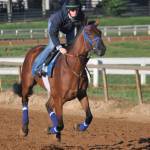Musculoskeletal Injury Risks in Training

Like human athletes, horses must stay in a regular program of physical activity and training in order to perform the work expected of them. To avoid injury, such a program must begin with short periods of gentle exercise and build slowly toward longer periods of more strenuous exercise. After the desired level of fitness is achieved, the horse must continue exercising to avoid losing this hard-won conditioning of the musculoskeletal, respiratory, and cardiovascular systems.
Training to race involves one of the most demanding equine exercise schedules. Musculoskeletal injuries are quite common among racehorses in training. A study conducted in New Zealand investigated factors—track surface, age, gender, race distance, season, training intensity, nutrition, and others— that influenced the risk of lower limb injuries to Thoroughbreds training and racing in that country.
For this study, information was collected monthly from 20 licensed Thoroughbred trainers over a period of 34 months. Training intensity was classified as 1) resting (not training for seven or more days); 2) walk or trot; 3) activity up to but not exceeding canter; 4) fast work but no racing; and 5) started in at least one race since the last data collection. A “training preparation” was defined as a period of time beginning when a horse entered or returned to work and ending when the horse was rested for at least seven days. Horses might have one or more training preparations during the study.
Data reduction produced several populations. The first was made up of 459 horses that sustained lower limb injuries while in a preparation, and was called the Training dataset. The second was a subset made up of those horses that had started in at least one race during the preparation that ended with a musculoskeletal injury. This set was called the Starting dataset. Control sets were made up of all preparation periods for horses that did not sustain musculoskeletal injuries; there were 2181 noninjury Training preparations and 1639 noninjury Starting preparations.
Results showed that horses five years of age and older were at somewhat more risk of injury than were two-year-olds. Horses in their third or later preparation had a lower risk than horses in their first preparation. In the Training set, risk of injury was lower in preparations of longer than 20 weeks compared to shorter preparations. As to length of racing distance, increasing cumulative distances were first associated with a reduction in risk of injury, then leveled out, and then were associated with an increased risk of injury as distances continued to increase. There was also an increased risk of injury among horses for which trials made up more than 20% of starts. Trials are defined as training runs under racing conditions, usually against other horses, for the purpose of educating horses or riders or as a means of gaining preference to start in a public race. A significant variation of risk among different trainers was found.
Many factors influence lower limb injuries in racehorses as they begin and continue their training and racing careers. While it is difficult to evaluate the effect of any particular factor while excluding all others, the theory has been advanced that visible injury is often due to the accumulation of mild to moderate damage over time at a rate that exceeds the healing capacity of the affected tissues. This theory is supported by the conclusions of this study, in which more injuries occurred to older horses and those that raced at the longest distances. While injuries were fewer in those horses that spent the most time training between races, this could be due to a more gradual increase in work, allowing the horse to adapt to exercise and to heal minor injuries before they led to visible lameness.
A conclusion reached by the investigators was that the risk of specific injuries could be age-dependent. For example, shin soreness was seen more commonly in younger racehorses, while tendon and ligament injuries were more common in older horses. This age-associated risk might be due to a decrease in healing or adaptive capacity in musculoskeletal structures as horses age. This type of decrease has been documented in previous research for tendons and ligaments.
Relatively few pleasure or performance horses need to be conditioned to the level of racehorses, but the knowledge uncovered by this study could be applied even to horses that will never be asked to run at top speed for a mile or more. By starting with gentle exercise, increasing demands slowly, and avoiding performance beyond the current level of fitness, owners have the best chance of keeping their horses injury-free.








